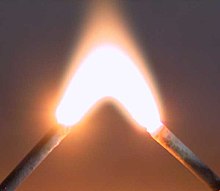
An electric arc (or arc discharge) is an electrical breakdown of a gas that produces a prolonged electrical discharge. The current through a normally nonconductive medium such as air produces a plasma, which may produce visible light. An arc discharge is initiated either by thermionic emission or by field emission.[1] After initiation, the arc relies on thermionic emission of electrons from the electrodes supporting the arc. An arc discharge is characterized by a lower voltage than a glow discharge. An archaic term is voltaic arc, as used in the phrase "voltaic arc lamp".
Techniques for arc suppression can be used to reduce the duration or likelihood of arc formation.
In the late 19th century, electric arc lighting was in wide use for public lighting. Some low-pressure electric arcs are used in many applications. For example, fluorescent tubes, mercury, sodium, and metal-halide lamps are used for lighting; xenon arc lamps have been used for movie projectors. Electric arcs can be utilized for manufacturing processes, such as electric arc welding, plasma cutting and electric arc furnaces for steel recycling.
- ^ "The Arc Species "Zoo"". Arc Suppression Technologies. 15 December 2020. Retrieved March 28, 2023.